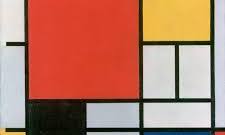The Artistic Legacy of Piet Mondrian
Piet Mondrian (1872–1944) was a Dutch painter known for his pioneering abstract art and role in the De Stijl movement. His distinctive style, characterized by geometric shapes and primary colors, has left a lasting impact on the world of modern art.
Early Life and Influences
Born in Amersfoort, Netherlands, Mondrian initially trained as a traditional artist before embracing abstraction. His early works were influenced by Impressionism and Post-Impressionism, but he soon began to experiment with geometric forms and non-representational art.
De Stijl Movement
Mondrian was a key figure in the De Stijl movement, which sought to create a universal visual language through abstract art. The movement emphasized simplicity, harmony, and order, principles that are reflected in Mondrian’s iconic compositions.
Geometric Abstraction
Mondrian’s most famous works feature grids of black lines intersecting with blocks of primary colors – red, yellow, and blue. These compositions are not only visually striking but also convey a sense of balance and harmony that transcends traditional artistic conventions.
Legacy and Influence
Mondrian’s influence can be seen in various artistic disciplines, from painting and sculpture to architecture and design. His emphasis on simplicity and purity of form continues to inspire artists around the world, making him a true pioneer of modern art.
Although Piet Mondrian passed away in 1944, his legacy lives on through his timeless artworks that continue to captivate audiences and spark creative exploration.
Exploring Piet Mondrian: 8 Insights into the Master of Geometric Abstraction
- Piet Mondrian was a Dutch painter known for his abstract art featuring geometric shapes.
- He was a key figure in the De Stijl movement, which emphasized simplicity and abstraction.
- Mondrian’s artwork often used primary colors (red, blue, yellow) along with black and white.
- His famous compositions typically consisted of straight lines intersecting at right angles.
- Mondrian believed that art should express universal harmony and order.
- He had a significant influence on modern art and design, inspiring many artists and architects.
- Mondrian’s later works became increasingly simplified, focusing solely on geometric forms and primary colors.
- His distinctive style continues to be celebrated for its innovative approach to abstract art.
Piet Mondrian was a Dutch painter known for his abstract art featuring geometric shapes.
Piet Mondrian, a renowned Dutch painter, is celebrated for his abstract art that prominently showcases geometric shapes. His innovative approach to art, characterized by a harmonious interplay of lines and primary colors, has solidified his place as a pioneering figure in the realm of modern art. Mondrian’s distinct style not only captivates viewers with its visual appeal but also conveys a profound sense of order and balance that continues to inspire artists and art enthusiasts worldwide.
He was a key figure in the De Stijl movement, which emphasized simplicity and abstraction.
Piet Mondrian played a pivotal role as a key figure in the De Stijl movement, a groundbreaking artistic movement that prioritized simplicity and abstraction in art. Emphasizing clean lines, geometric shapes, and primary colors, the De Stijl movement sought to create a universal visual language that transcended traditional artistic boundaries. Mondrian’s contributions to this movement not only reshaped the art world but also laid the foundation for modern abstract art, influencing generations of artists to come.
Mondrian’s artwork often used primary colors (red, blue, yellow) along with black and white.
Piet Mondrian’s distinctive artistic style was characterized by his bold use of primary colors – red, blue, and yellow – in combination with black and white. This unique color palette became a hallmark of his work, reflecting his commitment to simplicity and purity in art. By limiting his palette to these essential hues, Mondrian created compositions that were not only visually striking but also conveyed a sense of harmony and balance that transcended traditional artistic boundaries.
His famous compositions typically consisted of straight lines intersecting at right angles.
Piet Mondrian’s renowned artistic style often featured compositions characterized by straight lines intersecting at right angles. This distinctive approach to geometric abstraction created a sense of order and harmony in his artworks, emphasizing the simplicity and purity of form. By utilizing this precise arrangement of lines and angles, Mondrian was able to convey a visual language that transcended traditional artistic boundaries, leaving a lasting impact on the world of modern art.
Mondrian believed that art should express universal harmony and order.
Piet Mondrian held the belief that art should serve as a medium to express universal harmony and order. Through his iconic geometric compositions featuring intersecting black lines and blocks of primary colors, Mondrian sought to convey a sense of balance and unity that transcended individual experiences. His dedication to simplicity and purity of form in his artworks reflected his vision of creating a visual language that could resonate with audiences on a universal level, emphasizing the timeless principles of harmony and order in the realm of abstract art.
He had a significant influence on modern art and design, inspiring many artists and architects.
Piet Mondrian’s impact on modern art and design is undeniable, as he served as a major source of inspiration for numerous artists and architects. His innovative approach to geometric abstraction and his emphasis on simplicity and harmony have resonated across various creative disciplines. By pushing the boundaries of traditional artistic conventions, Mondrian paved the way for a new wave of creativity that continues to influence contemporary art and design practices.
Mondrian’s later works became increasingly simplified, focusing solely on geometric forms and primary colors.
Mondrian’s later works evolved towards a remarkable level of simplicity, honing in on geometric forms and primary colors as the sole elements of his compositions. By stripping away extraneous details and complexities, he achieved a purity of expression that defined his distinctive style. This shift towards essential elements showcased Mondrian’s commitment to exploring the fundamental principles of art, resulting in compositions that resonate with a timeless sense of balance and harmony.
His distinctive style continues to be celebrated for its innovative approach to abstract art.
Piet Mondrian’s distinctive style continues to be celebrated for its innovative approach to abstract art. His iconic compositions, characterized by geometric shapes and primary colors, have left a lasting impact on the art world, inspiring generations of artists to explore new possibilities in visual expression. Mondrian’s emphasis on simplicity, harmony, and order in his work has established him as a trailblazer in modern art, with his legacy enduring as a beacon of creativity and artistic exploration.





